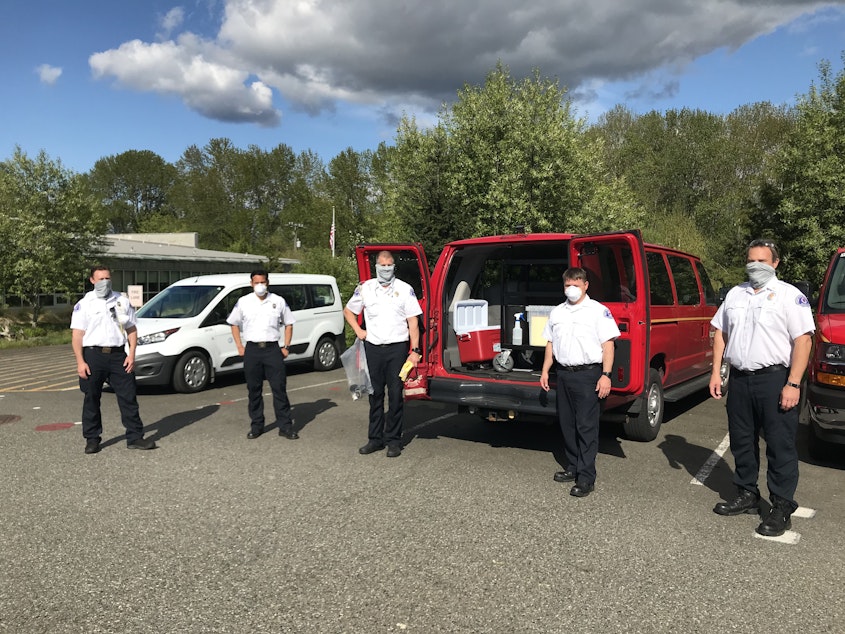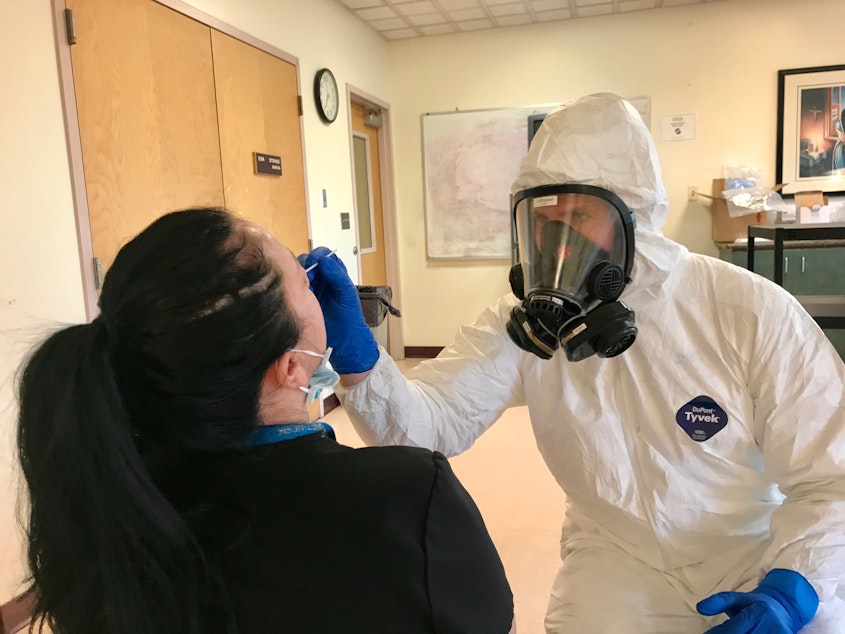A Seattle paramedic on bringing mobile coronavirus testing to local nursing homes

Seattle Fire Department paramedic Brian Wallace helped launch Covid-19 testing for first responders in March. Now the agency's mobile teams are expanding to the city’s nursing homes. What they’re seeing: tension, anxiety, gratitude and relief.
Lt. Wallace spoke to KUOW's Amy Radil. This interview has been lightly edited for clarity.
In early March, Chief Scoggins realized it was almost impossible for us to get timely tests of our own members and that we would lose the resiliency of our workforce if we weren’t able to figure out who was sick and who wasn’t. They recognized the need for us to do our own testing.
Previously, a nasal swab was not a skill that EMTs or paramedics were allowed to perform in the state of Washington. The Washington State Department of Health mobilized quickly to make this possible for us.
In about two days -- in partnership with the Seattle Police Department -- we put together a drive-through clinic. We operated that for several weeks before the Chief realized that we needed to help do some of the testing in long term care facilities where there simply wasn’t enough personnel from the other entities to make that happen in a timely way. That became a partnership with Public Health Seattle-King County to identify the facilities that were most at risk: places where they’d had outbreaks or where they hadn’t been able to make any contacts yet with teams from local hospitals.
So we used the workflow we’d developed from the first responder testing clinic to establish a mobile team that could use a cart instead of a drive-up site to go into these skilled nursing facilities to test them. It’s called a "point prevalence survey" where we test all staff and all residents to find out if we can identify any previously undetected cases and isolate those people and help contain the spread within those facilities.
Because of social distancing in place, and because facilities are actually doing a really good job of managing infection control plans, we’re not seeing cases at a much higher rate at this point than we are in the general population.
But when they take root in these places they obviously have much worse consequences. So it’s very satisfying to find asymptomatic positive cases among staff members particularly, because we know that was a person who would have been unaware that they could have spread this virus to someone who was vulnerable.
We identify a place that works well for us – in most of these facilities they have a dining hall that’s not currently being used, or an activity center. We set up a nice large room with plenty of room to do social distancing and line people up so we can organize them.
But not all these facilities have that ability. Or they’ve had a greater impact from the disease and they’re in a much more intense phase of isolation. Or they have residents that are simply not mobile and they’re bed-bound. In that case we kind of do a combination of testing people at that single funnel point and also going room to room, and testing people that need to be tested that way.

We’ve also just started testing in adult family homes, which is usually what appears to be just a normal private residence that has up to six people living in it and 2-4 staff members that rotate through or potentially live there as well. In these congregate living settings, they’re at high risk of infecting one another and they have a lot of shared spaces. We try to find a place outside if possible, where there’s good ventilation.
I would say there are definitely facilities where there is a palpable level of tension and anxiety around any kind of interaction with each other, with us.
Even in those facilities, people are very relieved to be getting these tests, there’s a lot of comfort in knowing. So regardless of how much disease they’ve been dealing with in these facilities, they’re excited to see us come in and perform the test for them. People are overwhelmingly grateful in most cases.
In one of the homes where we tested, it was just after Easter and they’d just had a large donation from See’s Candies. So every resident that got tested got to choose between a giant box of chocolate and a chocolate bunny. There was a 94-year-old woman when I happened to be watching that table for a minute, and this little old lady picked a chocolate bunny and said it was the first time in 94 years that anyone had given her a chocolate rabbit for Easter. I thought that was really sweet.
For a small adult family home, it becomes a very serious crisis if they have a staff member who’s infected or in some cases several staff members, because now there is no longer anyone who can safely take care of their patients. There are staff that need to work in different areas: dining staff, housekeeping, skilled nursing. That seems like a great challenge.
Most of them are doing this very well. I’ve really seen good adherence to the county and CDC guidelines around infection control. And residents themselves are wearing masks, they are keeping at a safe distance from each other. And they’re still spending time together, they’re sitting and chatting, but they’re doing it from six feet away.
The places that have confirmed cases definitely have priority. We want to try to limit the spread of those cases as much as we can, obviously. But this adult family home pilot project involves mostly testing in places that have not reported a case. However, in some instances those family homes have staff members who have had contact with someone who has tested positive and now they’re very worried and have a high level of anxiety about it getting into their home. And these are not places where it’s easy to practice social distancing or for everyone to wear PPE all the time, that’s not really the level of training that a lot these staff members have.
We’ve been in a total of 14 different facilities counting both adult family homes and skilled nursing, and administered 893 tests. The pace is increasing as we recognize the significance of this broad-based testing to reopening our community and keeping this population safe. We are looking to scale this up even further than we already have.
It’s my understanding that we are going to assist with some of the community testing centers (where you can drive in without an appointment and go through some screening and in most cases get a swab test performed right then and there). So I anticipate that Seattle Fire Department will be very busy with this testing for the foreseeable future.
I do enjoy doing this, it’s very satisfying to give a facility peace of mind of either knowing that they don’t have any result and they’re doing the right thing to protect their people, or they have some cases they need to isolate and they can take action at that. I think one of the things that’s the most stressful for all of us is just not knowing exactly where the virus is.
Having adequate personal protective equipment (PPE) has been an ongoing struggle for the past couple of weeks and I feel confident that that barrier is about to fall away. The city has very aggressively sourced supplies. The county is also getting supplies. I think we’ll have, at least for the short term, the equipment we need to start doing some significant testing.
It has surprised me how significant the policy barriers to testing have been at this point in the pandemic. I have been surprised to be wrestling with insurance issues and issues of establishing a standing order by a physician for a test this late in the game. But everyone has been working hard, the team at Public Health, the Mayor’s office, the Fire Chief have all been working extraordinarily hard to remove these policy barriers. And I do feel like in the next couple of weeks things are going to change significantly.
In the brightest possible future, we have a vaccine for this virus and we can start using these mobile teams to deliver vaccines to people instead of nasal swabs. And that will require another change in scope for paramedics, and I know the DOH is already working on that.




